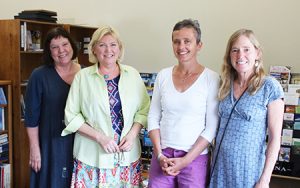
By Michael Howell
An ambitious effort has begun to promote the three National Historic Trails that pass through the Bitterroot Valley: The Lewis and Clark Trail, the Nee-Me-Poo (Nez Perce) Trail, and the Ice Age Floods Geologic Trail. Thanks to a couple of grants, $15,000 from the Nez Perce Tribe and another $15,000 from the Lewis and Clark Trail, the Bitter Root Cultural Heritage Trust has hired a couple of consultants to help design an interpretive scheme to educate not just visitors to the area, but the local residents as well, about the existence and significance of these historic trails.
The consultants, Marina Richie, an interpretive writer from Bend, Oregon, and Maja Smith, a graphic design artist from Burlington, Vermont, are working in tandem to develop a plan that includes a lot more than just interpretive signs. It may involve oral presentations, traveling exhibits, audio apps, and other means of “telling the story” of these three trails.
“It’s a great way for people to learn about a place, by hearing the stories that lay across the landscape,” said BRCHT Director Kristine Komar. She said the Lewis and Clark Trail, for instance, was over 3,000 miles long. “But we have stories that live here, like the horses given to the Corps of Discovery by the Salish at Ross’s Hole. Without those horses, the journey may have taken a very different turn.”
The interpretive consultants work together to weave words and images into a thematic and engaging network of interpretive signs and kiosks that do more than relate a few facts.
Interpretive signing is an art, according to Richie. She said it involves communicating a message, not just listing some facts. Instead of just slapping up a sign that says “Lewis and Clark stopped here,” she said it means looking a little deeper into things.
“You could look a little deeper into navigation,” said Richie, “and ask how did they find their way. You could explore how we travel today compared to back then. How did they cross the river?” She said the aim was not to just inform people about the facts, but to engage them and get them thinking about things in some depth.
Fresh off a project in Oregon, where they designed an interpretive scheme for the Wildlife Refuge that runs along the entire Oregon coastline, Richie said that this project is more of a challenge. Here, she said, there are three trails with different histories and different stories to tell that must somehow be braided together.
“This is a much more challenging and complex project,” said Richie. She said it is not just braiding the three trails together, but also includes other stories in the Bitterroot that can also be woven into the theme.
“It’s all about making connections, “said Richie. “It’s not just about three trails. We are looking at how all the other stories of the valley relate to these trails.”
Both Richie and Smith were in the Bitterroot recently scoping out the area, visiting sites along the trails and talking with the locals. Besides stopping at various historic sites along the trails, the consultants also visited with local groups and individuals in Darby, Hamilton, Corvallis, Victor and Stevensville. Richie called it the “gathering” phase of their work in which they get a feel for the place and the people.
Smith said that it was important not to see this as just a “tourism project.” It is also about the local people, she said.
“To be successful in building tourism, you have to build it for yourself,” said Smith. “You have to take ownership of the story.”
Lorraine Roach, Director of the Stevensville Main Street Association, said, “As the oldest pioneer community in Montana, we certainly think of history as one of the big draws to this community and something that’s valued by the people who live here as well as travelers.” She said being the homeland of the Salish was a big part of the story of the Nez Perce Trail.
“We think it is important to tell, not only the stories of Stevensville, but the bigger picture and the broader context as well. This is one more chance for us to be part of something bigger than us but which we are also a big part of,” she said.